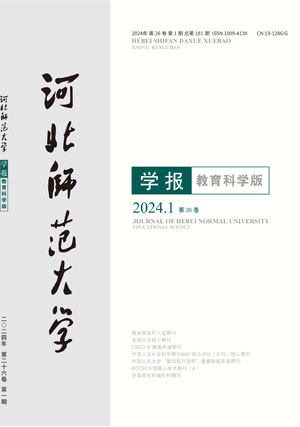期刊信息

- 刊名: 河北师范大学学报(教育科学版)Journal of Hebei Normal University (Educational Science Edition)
- 主办: 河北师范大学
- ISSN: 1009-413X
- CN: 13-1286/G
- 教育部名栏入选期刊
- 全国中文核心期刊
- CSSCI扩展版来源期刊
- AMI综合评价(A刊)核心期刊
- RCCSE中国核心学术期刊
- 全国高校特色栏目社科学报
- 中国人民大学“复印报刊资料”重要转载来源期刊
- 全国高校权威社科期刊
成效·局限·改革:“G-U-S”三位一体协同育师机制审思
-
作者单位:(长江大学 教师教育研究中心,湖北 荆州 434023) -
起止页码:110 - 115页 -
DOI:10.13763/j.cnki.jhebnu.ese.2023.01.014
Reflections on the “G-U-S” Three-pronged Teacher Co-cultivation Mechanism: Achievements, Limitations and Reform
摘要/Abstract
“G-U-S”三位一体协同育师机制是指,政府、高校、中小学(含幼儿园)三方各司其职,责任共担、协同培育教师的一种制度形式与工作方式。现有的三位一体协同育师机制尽管促进了教师培育成效提高、教师教育资源整合、区域教育均衡发展及教师专业水平持续提升,但仍然存在相关决策主体单一、三元主体权责不明、培育方案不够成熟、协同培育管理不够协调等局限。为进一步提升“三位一体”协同育师机制的成效,理应构建具有一定行政职能的协同育师主体联盟,明晰“三位”主体各自的权责,完善协同育师培育方案,促进协同培育管理更加协调。
The “G-U-S” three-pronged teacher co-cultivation mechanism refers to an institutional form and working mode in which the government, universities, primary and secondary schools (including kindergartens) perform their respective duties, share the responsibilities, and cultivate teachers in collaboration. Although the existing three-pronged teacher co-cultivation mechanism has promoted the improvement of teacher cultivation, the integration of teacher education resources, the balanced development of regional education and the continuous improvement of teachers’ professional level, there are still some limitations, such as the single decision-making subjects, the unclear rights and responsibilities of the three subjects, the immature teacher cultivation program and the uncoordinated co-cultivation management. In order to further enhance the effectiveness of the three-pronged teacher co-cultivation mechanism, it is necessary to build a teacher co-cultivation subject alliance with certain administrative functions, clarify the respective rights and responsibilities of the three subjects, improve the teacher co-cultivation programs, and promote more coordinated co-cultivation management.
关键词
参考文献 12
- [ 1 ] 教育部.关于实施卓越教师培养计划2.0的意见 [EB/OL]. (2018-11-19) [2019-01-25]. http://www.moe.edu.cn/srcsite/A10/s7011/201810/t20181010_350998.html.
- [ 2 ] 李中国.两种“三位一体”教师教育模式比较研究 [J]. 教育研究,2014(8):113-117.
- [ 3 ] 李中国,辛立春,赵家春.G-U-S 教师教育协同创新模式实践探索——以山东省教师教育改革为例 [J]. 教育研究,2013(12):144-148.
- [ 4 ] 刘益春,李广,高夯.“U-G-S”教师教育模式实践探索——以“教师教育创新东北实验区”建设为例 [J]. 教育研究,2014(8):107-112.
- [ 5 ] 孔凡哲,彬彬.U-S合作的焦点:以专业引领 促学校发展— —以大学与地方政府合作办学为例 [J]. 教育发展研究,2014(8):61-65.
- [ 6 ] 中央教育科学研究所比较教育研究室.简明国际教育百科全书(教育管理) [M]. 北京:教育科学出版社,1997.
- [ 7 ] 中国社会科学院语言研究所词典编辑室.现代汉语词典 [M]. 北京:商务印书馆,2016.
- [ 8 ] 初铭铜.高校与地方政府、中小学“三位一体”协同培养教师新机制建立的难点解析 [J]. 教师教育论坛,2016(3):22-28.
- [ 9 ] 朱洪翠,张景斌,高建春.四维互动:卓越教师“三位一体”协同培养机制的模型构建 [J]. 教学研究,2017(3):43-49.
- [ 10 ] 肖其勇.农村小学全科教师协同培养机制探索 [J]. 中国教育学刊,2015(5):81-85.
- [ 11 ] 戴伟芬.学术性与师范性的抉择与融合——美国教师教育课程思想流变 [J]. 教师教育研究,2012(1): 93-96.
- [ 12 ] 胡元林,曹如军.治理视角下教师教育“三位一体”协同育人的优化 [J]. 教师教育研究,2021(2):17-22.
